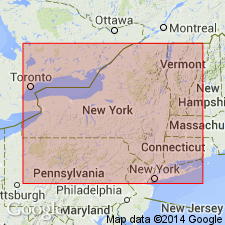
- Usage in publication:
-
- Manlius water lime group
- Modifications:
-
- Original reference
- Dominant lithology:
-
- Limestone
- AAPG geologic province:
-
- Appalachian basin
Summary:
Pg. 376. Manlius water lime group. Embraces all beds of water lime south of Erie Canal which are burnt for lime. Very constant in character. I have traced it from Cayuga Lake to hills in rear of Hudson. Its layers are dark blue and drab. It occupies interval between base of PENTAMERUS limestone [Coeymans limestone] (underlying DELTHYRIS shaly limestone) and top of Onondaga salt group, which consists of salines and gypsum. [As thus defined the unit apparently included Manlius, Rondout, and Cobleskill limestones and also Bertie limestone member of Salina formation. In 1839 (3rd Ann. Rpt. Geol. Survey 3rd dist., New York, p. 272) Vanuxem described the Waterlime group of Manlius as overlying "saliferous group of Onondaga" and underlying Oriskany sandstone.] Age is Late Silurian.
Named for Manlius, Onondaga Co., NY.
Source: US geologic names lexicon (USGS Bull. 896, p. 1283-1285).
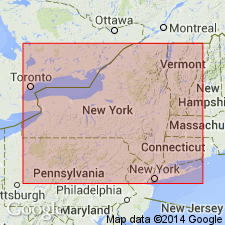
- Usage in publication:
-
- Manlius water limestones
- Modifications:
-
- Overview
- AAPG geologic province:
-
- Appalachian basin
Summary:
Pg. 86. Applied Manlius water limestones to beds between PENTAMERUS limestone and Onondaga salt group [the latter described as consisting of gray and porous limestone (pyritous limestone), gypsum, red and variegated shales, etc., essentially same as Salina formation of present terminology].
Source: US geologic names lexicon (USGS Bull. 896, p. 1283-1285).
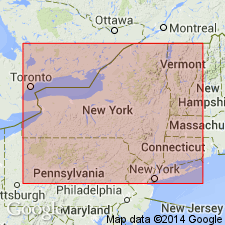
- Usage in publication:
-
- Manlius waterlime
- Modifications:
-
- Overview
- AAPG geologic province:
-
- Appalachian basin
Summary:
Pg. 429. Applied Manlius waterlime to beds between PENTAMERUS limestone above and Onondaga salt and plaster rock below. The same beds (overlain by PENTAMERUS limestone and underlain by Onondaga salt group) were called Water-lime group by Vanuxem in 1842, and Manlius waterlimes and thin shales by E. Emmons in 1846 (Agric. N.Y.)
[GNC remark (US geologic names lexicon, USGS Bull. 896, p. 1283-1285): For many succeeding years [between 1842 and 1899] the term "Waterlime group" continued to be applied to the strata between "Lower Helderberg group" and "Onondaga salt group." In some reports, however, the unit was included in "Lower Helderberg group" and in other reports it was included in "Onondaga salt group." The name Manlius was dropped for many years.]
Source: US geologic names lexicon (USGS Bull. 896, p. 1283-1285).
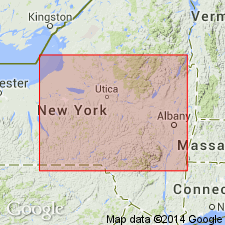
- Usage in publication:
-
- Manlius limestone
- Modifications:
-
- Revised
- AAPG geologic province:
-
- Appalachian basin
Summary:
Pg. 874-878. Manlius limestone (the Tentaculite limestone of Gebhard, Mather, and later writers). Underlies Coeymans limestone (basal formation of Helderbergian group) and overlies Rondout waterlime. The name here used was introduced by Vanuxem and is entitled to first consideration. Is top formation of Cayugan group, which includes Salina formation at base. [In 1900 (GSA Bull., v. 11, p. 251) Schuchert gave thickness of Manlius or Tentaculites limestone as 50 to probably 300 feet or more.]
Source: US geologic names lexicon (USGS Bull. 896, p. 1283-1285).
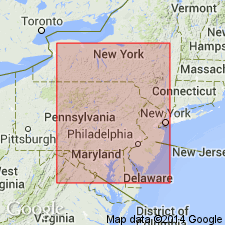
- Usage in publication:
-
- [Manlius limestone]
- Modifications:
-
- Contact revised
- AAPG geologic province:
-
- Appalachian basin
Summary:
Pg. 658. Classified Decker Ferry [Decker limestone] as occupying position between the Manlius and Rondout. The relations of the Decker to the Manlius and Rondout are, however, still in question.
Source: US geologic names lexicon (USGS Bull. 896, p. 1283-1285).
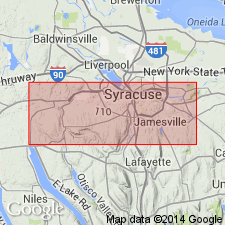
- Usage in publication:
-
- Manlius group
- Modifications:
-
- Revised
- AAPG geologic province:
-
- Appalachian basin
Summary:
Pg. 25-36. Manlius group. If Manlius is to be employed with anything like its original value, the group represented comprises 6 stratigraphic units at the very least. These 6 [formations] are all present at Manlius, Onondaga County, and are here given geographic names, as follows (descending): (1) Bishop Brook limestone (Helderbergian fauna), (2) Pools Brook limestone, (3) Jamesville limestone, (4) Clark Reservation limestone, (5) Elmwood beds, and (6) Olney limestone. The beds unconformably underlie Oriskany sandstone and rest on a sun-cracked waterlime which forms quarry floor at type locality, and is thought to be below or at least near lower limit of SPIRIFER VANUXEMI [brachiopod] in central Onondaga County. Without being distinguished, Nos. 3 and 4 have been classed as Helderbergian by some authors, but they are undoubtably included in Vanuxem's Manlius. One can hardly escape conclusion that upper part of Rondout of Hopkins (1914) [?Geol. of Syracuse quadrangle, New York State Mus. Bull., no. 171] and lower part of Hartnagel's 1903 [New York State Mus. Bull., no. 69] Manlius are identical.
Source: US geologic names lexicons (USGS Bull. 896, p. 1283-1285; USGS Bull. 1200, p. 2356-2357).
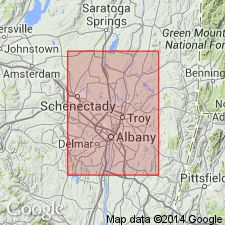
- Usage in publication:
-
- [Manlius limestone]
- Modifications:
-
- Overview
- AAPG geologic province:
-
- Appalachian basin
Summary:
Pg. 27. Included all of Manlius in Silurian.
Source: US geologic names lexicon (USGS Bull. 896, p. 1283-1285).

- Usage in publication:
-
- Manlius limestone*
- Modifications:
-
- Overview
- AAPG geologic province:
-
- Appalachian basin
Summary:
GNC remark on classification and age; a summary of reports between 1903-1929.
In March 1903 (Amer. Geol., v. 31, p. 160-175), Schuchert "redefined" Manlius, calling the beds Manlius formation, which he described as 50 to 126 feet thick, as underlying Coeymans limestone of Helderbergian group, as overlying Bertie formation (forming top of Salina and formerly called "Lower Waterlime"), and as including Manlius (Tentaculite) limestone, Rondout limestone (restricted to "Upper Waterlime"), and Cobleskill limestone (new name applied to 7 to 30 or more feet of strata formerly called "Coralline limestone" and included in the Rondout). Schuchert stated: This will be more in harmony with Vanuxem's conclusion, since he included the horizon having the Cobleskill fauna in his Manlius formation. From his definition of this formation usage long ago excluded the lower Waterlime, and this part is here referred to as the Bertie limestone. J.M. Clarke (in his Handbook published in July 1903), also C.A. Hartnagel (New York State Mus. Bull., no. 69, 1903), adopted the following classification: Manlius limestone, Rondout waterlime, Cobleskill limestone, and Salina formation. In 1905 (New York State Mus. Bull., no. 82) J.M. Clarke and D.D. Luther used Manlius group to include Manlius limestone (75 feet thick), Rondout dolomite or waterlime (40 feet thick), and Cobleskill dolomite. The broad use of Manlius apparently did not find favor with geologists, who, excepting Berkey, 1911, have continued to recognize the three subdivisions Manlius, Rondout, and Cobleskill. Berkey (New York State Mus. Bull., no. 146) suggested it might be better to group the beds between top of the Manlius and base of the Cobleskill into a single unit and call it Manlius series [† later discarded].
In 1911 (GSA Bull., v. 22, pl. 28) E.O. Ulrich placed in Helderberg group of New York a formation beneath Coeymans limestone which he called Keyser limestone, taking the name from a locality in West Virginia. The beds beneath the Keyser he designated as "Tentaculite limestone," "Cement rock," and "Cobleskill limestone." In 1913 (Maryland Geol. Survey Lower Devonian volume, p. 115-116) Ulrich stated that the Keyser represents "Manlius of the literature," and rests on the Rondout, beneath which comes the Decker Ferry [Decker]. These three formations he included in Devonian. But he stated that the typical Manlius underlies the Decker and overlies the Cobleskill, is of Silurian age, and is absent at Rondout, where the Keyser rests on Rondout and Rondout rests on Decker. In same volume C.K. Swartz, C. Schuchert, and C.S. Prosser classified the Manlius of eastern New York and New Jersey as Lower Devonian, and Schuchert so classified it in the 1924 edition of his Textbook of geology.
The relations and age of typical Manlius, typical Rondout, Decker limestone, and Cobleskill limestone are matters about which geologists are not yet agreed.
Source: US geologic names lexicon (USGS Bull. 896, p. 1283-1285).
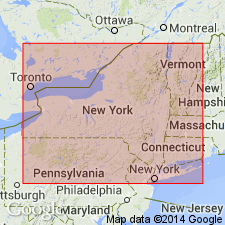
- Usage in publication:
-
- [Manlius limestone]
- Modifications:
-
- Overview
- AAPG geologic province:
-
- Appalachian basin
Summary:
Pg. 318, 346-347. When Clarke transferred Helderberg limestones to Devonian, the Manlius was, because of rather Silurian aspect of its meager fauna, left in Silurian, and since then has been subject of much discussion as to age. Some, following Clarke, class entire Manlius as Silurian, others would place it in Devonian, and a third group place Devonian-Silurian boundary within the Manlius. In eastern Helderberg region a distinct irregular unconformity occurs between the Manlius and overlying Coeymans. The Upper Manlius beds of western New York are considered as Keyser, and Devonian, by Ulrich. [In this 1931 report the Manlius is described under Silurian heading, and on p. 191, 317, and 318 it is included in Silurian, but in tables on p. 190 and 192 Upper Manlius or Keyser (in parens) is included in Devonian. It is shown as overlying the Rondout.]
Source: US geologic names lexicon (USGS Bull. 896, p. 1283-1285).
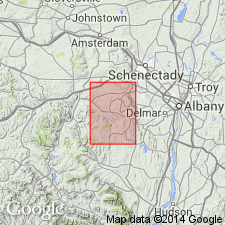
- Usage in publication:
-
- Manlius limestone
- Modifications:
-
- Overview
- AAPG geologic province:
-
- Appalachian basin
Summary:
Assigned Manlius limestone to Silurian.
Source: US geologic names lexicon (USGS Bull. 896, p. 1283-1285).
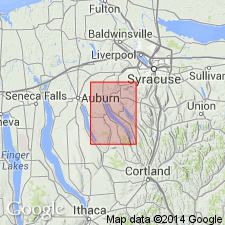
- Usage in publication:
-
- [Manlius group]
- Modifications:
-
- Overview
- AAPG geologic province:
-
- Appalachian basin
Summary:
Pg. 68. Olney limestone and Elmwood waterlime have been very generally assigned to Silurian, and there appears to be no good reason for questioning this practice. A system reference for Clark Reservation and Jamesville limestones rests perhaps upon less secure ground. Inasmuch, however, as positive Devonian relations have not been proved for these higher units it is deemed best to include them in Silurian.
Source: US geologic names lexicon (USGS Bull. 896, p. 1283-1285).
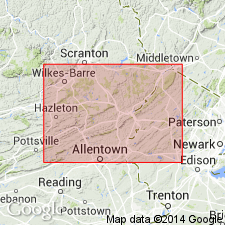
- Usage in publication:
-
- Manlius limestone
- Modifications:
-
- Revised
- AAPG geologic province:
-
- Appalachian basin
Summary:
Pg. 1182-1184. Term Keyser group proposed to include Decker sandstone, Rondout limestone, and Manlius limestone. These formations replace Keyser limestone in northern area. Manlius limestone is equivalent to part of White's (1882) [Pennsylvania Geol. Survey Rpt. Prog., 2nd ser., v. G6] Stormville limestone and conglomerate.
Source: US geologic names lexicon (USGS Bull. 1200, p. 2356-2357).
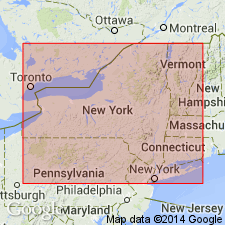
- Usage in publication:
-
- [Manlius limestone]
- Modifications:
-
- Contact revised
- AAPG geologic province:
-
- Appalachian basin
Summary:
Pg. 5-29. Transitional Manlius-Coeymans contact discussed in upper New York state. Manlius section measured at edge of town of Manlius. Unit names used for this section were proposed by Smith (1929, New York State Mus. Bull., no. 281); Jamesville and Pools Brook limestones represent upper two members of Manlius; Bishop Brook limestone is considered Coeymans in age.
Source: US geologic names lexicon (USGS Bull. 1200, p. 2356-2357).
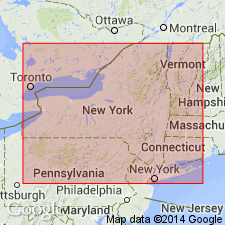
- Usage in publication:
-
- Manlius group
- Manlius formation
- Modifications:
-
- Overview
- AAPG geologic province:
-
- Appalachian basin
Summary:
Pg. 2, 3-4. Columnar section (page 2) shows Manlius group comprises (ascending) Cobleskill, Rondout, and Olney limestone members, and Elmwood beds. Overlies Salina group; underlies Clark Reservation and Jamesville limestone shown as transitional beds between Manlius group and Helderberg group. Pages 3 and 4 refer to Manlius formation comprising above named members.
Source: US geologic names lexicon (USGS Bull. 1200, p. 2356-2357).

- Usage in publication:
-
- Manlius formation
- Modifications:
-
- Revised
- Age modified
- AAPG geologic province:
-
- Appalachian basin
Summary:
Pg. 7 [section by L.V. Rickard]. Formation subdivided into (ascending) Thacher (new), Olney, Elmwood, Clark Reservation, and Jamesville members. The higher limestone members named by Smith (1929) [New York State Mus. Bull., no. 281] pass laterally in Coeymans limestone of eastern New York and hence are undoubtedly of Devonian age. Overlies Rondout formation. Helderbergian series. Lower Devonian. Coeymans limestone of central New York, overlying Jamesville member of Manlius, is entirely younger than Coeymans of eastern New York. Name Deansboro proposed for this member of Coeymans.
Source: US geologic names lexicon (USGS Bull. 1200, p. 2356-2357).
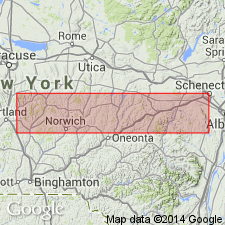
- Usage in publication:
-
- Manlius formation
- Modifications:
-
- Revised
- Age modified
- AAPG geologic province:
-
- Appalachian basin
Summary:
Pg. 1608. Westward from Helderbergs of eastern New York, Coeymans limestone thickens to nearly 100 feet at Cherry Valley. This thickened Coeymans splits into three parts --lower and middle parts grade laterally into Olney, Elmwood, Clark Reservation, and Jamesville members of type Manlius. Thus nearly all of Manlius of central New York is facies of Coeymans of eastern New York and should be included in Lower Devonian. Manlius of eastern New York is entirely pre-Olney. It thins westwardly, is absent west of Jamesville, and is seemingly replaced by underlying thickening Rondout dolomite.
Source: US geologic names lexicon (USGS Bull. 1200, p. 2356-2357).
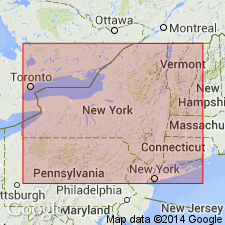
- Usage in publication:
-
- Manlius formation
- Modifications:
-
- Revised
- Age modified
- AAPG geologic province:
-
- Appalachian basin
Summary:
Pg. 102. West of Cherry Valley, the thickened Coeymans splits into three parts. Lower part, for which name Dayville limestone is proposed, grades laterally into Olney limestone of Syracuse area. Middle part changes into Elmwood, Clark Reservation, and Jamesville members of Manlius. For upper beds of Coeymans, which continue westward as far as Chittenango Falls, name Deansboro limestone is proposed. Bishop Brook limestone at Manlius is a reappearance of the Deansboro further west. Evidence indicates that entire type Manlius near Syracuse, central New York, is equivalent in age to Lower Devonian Coeymans and Kalkberg formations of eastern New York. So-called Manlius of eastern New York is entirely older; name Thacher limestone is proposed for this latter unit. Helderbergian series.
Source: US geologic names lexicon (USGS Bull. 1200, p. 2356-2357).
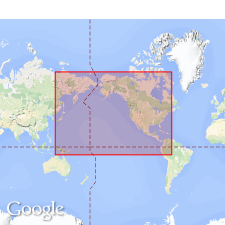
- Usage in publication:
-
- Manlius limestone*
- Modifications:
-
- Overview
- AAPG geologic province:
-
- Appalachian basin
Summary:
Pg. 2356-2357. Manlius limestone of Helderberg group. USGS currently [ca. 1960] classifies the Manlius limestone as formation in the Helderberg group on the basis of a study now in progress. Age is Early Devonian.
Source: US geologic names lexicon (USGS Bull. 1200, p. 2356-2357).
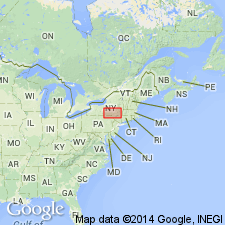
- Usage in publication:
-
- Manlius limestone
- Modifications:
-
- [Revised]
- AAPG geologic province:
-
- Appalachian basin
Summary:
[See entry under Berdan (1964).]
Source: US geologic names lexicon (USGS Bull. 1200, p. 2356-2357); Changes in stratigraphic nomenclature, 1964 (USGS Bull. 1194-A, p. A17).
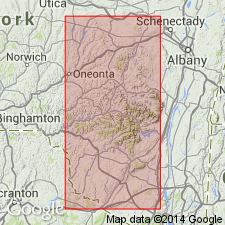
- Usage in publication:
-
- Manlius Limestone*
- Modifications:
-
- Overview
- AAPG geologic province:
-
- Appalachian basin
Summary:
Pg. B8-B9 (fig. 2), B14-15, 16. In this report author summarizes and evaluates the nomenclature applied to Upper Silurian through Lower Devonian strata in New York, from the work of Timothy Conrad in 1839 to the present. Special attention is made to the placement and age of the Manlius Limestone. Rickard, 1962 (New York State Mus. Bull., no. 386, 157 p.) traced the members of the Manlius Limestone eastward to the vicinity of Vanhornesville, New York, and demonstrated that the decrease in thickness of the Manlius is due to interfingering with the Coeymans Limestone, rather than an unconformity as believed by earlier workers. He concludes (Rickard, 1962, p. 117-119) that the Silurian-Devonian boundary is below the Manlius Limestone, and that the Manlius belongs with the Helderberg Group and is Early Devonian in age. Rickard named the crinoidal limestone of Coeymans lithology which occurs beneath the Clark Reservation and Elmwood Members of the Manlius at Dayville and Jordanville the Dayville Member of the Coeymans and applied the name Deansboro Member of the Coeymans to the crinoidal limestone overlying the Jamesville Member of the Manlius. He has also named a new member of the Manlius, the Thacher, which is exposed in the Helderberg escarpment. In his opinion (1962, p. 93-97), the Manlius Limestone represents a lithified calcareous ooze, whereas the Coeymans Limestone is a lime sand, and the two facies interfinger. Comparison of faunas (e.g., brachiopods and ostracodes) of the Dayville Member of Coeymans (Devonian), type Manlius, and Cobleskill Limestone (Silurian) shows that the type Manlius is closely related to the Coeymans faunally and is entirely distinct from the Cobleskill. Thus, Rickard's conclusion that the Manlius belongs in the Helderberg Group and should be considered Lower Devonian seems entirely justified. Report includes nomenclature history, correlation chart, faunal lists. Lower Devonian Manlius Limestone of Helderberg Group adopted by the USGS.
Source: US geologic names lexicon (USGS Bull. 1200, p. 2356-2357); Changes in stratigraphic nomenclature, 1964 (USGS Bull. 1194-A, p. A17).
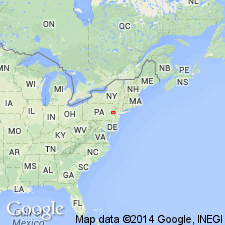
- Usage in publication:
-
- Manlius Limestone*
- Modifications:
-
- Areal extent
- AAPG geologic province:
-
- Appalachian basin
Summary:
Pg. 2 (fig. 1), 16-17, pl. 1. Manlius Limestone of New Jersey is represented only by the Thacher Member (Rickard, 1962, New York State Mus. Bull., no. 386, 157 p.) northeast of Hainesville. Consists of medium-dark-gray to dark-gray, very fine-grained, massive "ribbon" limestone. Southwest of Hainesville, becomes arenaceous and argillaceous and grades gradually into the Depue Limestone Member (new) of Coeymans Formation. To facilitate mapping, an arbitrary cutoff is used to separate the Thacher from the Depue. Age is considered Late Silurian and Early Devonian. Report includes measured sections.
Source: Publication; GNU records (USGS DDS-6; Reston GNULEX).
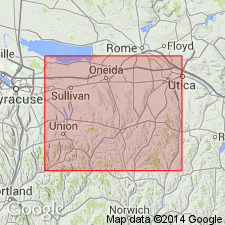
- Usage in publication:
-
- Manlius Formation
- Modifications:
-
- Areal extent
- AAPG geologic province:
-
- Appalachian basin
Summary:
Manlius Formation. Basal formation of Helderberg Group. Succession of Lower Devonian carbonates exposed across central and eastern New York. Here divided into six subfacies: grainstone, microbial bioherm, wavy to lenticular thin bedded, laminite, disrupted mudstone, and thin beddite subfacies.
Source: GNU records (USGS DDS-6; Reston GNULEX).
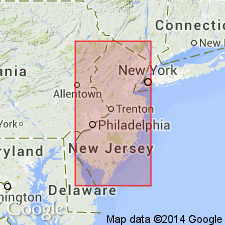
- Usage in publication:
-
- Manlius Limestone*
- Modifications:
-
- Age modified
- Biostratigraphic dating
- Areal extent
- AAPG geologic province:
-
- Appalachian basin
Summary:
Age of Manlius Formation refined to early Lochkovian. One specimen of conodont ICRIODUS WOSCHMIDTI, an auxiliary guide to base of Devonian, was found 2.6 m below top of Manlius at location PJS-1 of Denkler and Harris (1988), confirming Devonian age based on regional relationships. Southwest of Montague, New Jersey, beds correlative to Manlius become increasingly quartzose and are included in the more heterogeneous Coeymans Formation.
Source: GNU records (USGS DDS-6; Reston GNULEX).
For more information, please contact Nancy Stamm, Geologic Names Committee Secretary.
Asterisk (*) indicates published by U.S. Geological Survey authors.
"No current usage" (†) implies that a name has been abandoned or has fallen into disuse. Former usage and, if known, replacement name given in parentheses ( ).
Slash (/) indicates name conflicts with nomenclatural guidelines (CSN, 1933; ACSN, 1961, 1970; NACSN, 1983, 2005, 2021). May be explained within brackets ([ ]).

